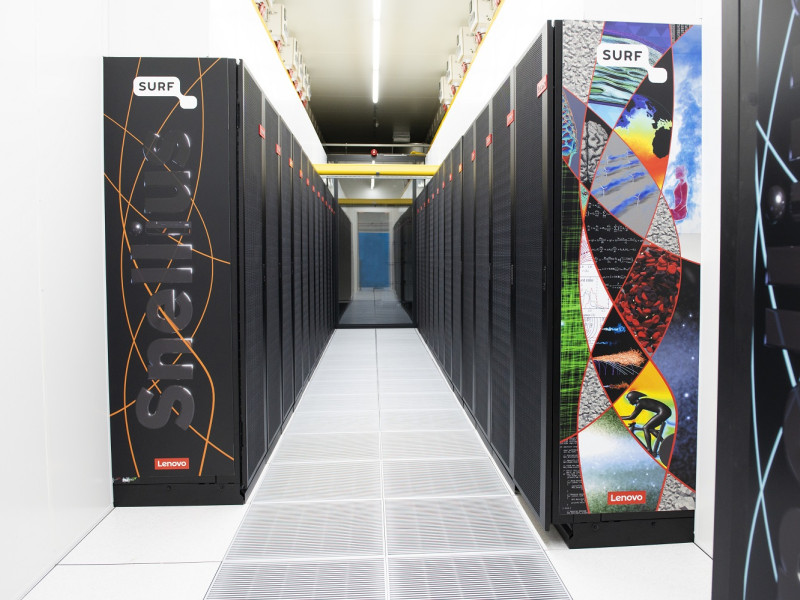With Snellius, we can answer new questions about what is happening to the climate as a result of the increase in greenhouse gases. We can also make more detailed projections for the climate of the future, especially the occurrence of extremes such as heat waves and excessive precipitation. You need a supercomputer because of the scale of the calculations and the amount of data involved. These kinds of calculations cannot be done on a laptop.
4 questions about the new supercomputer
The new supercomputer Snellius has been officially inaugurated by Queen Máxima. With Snellius, Dutch researchers will be able to face even more scientific challenges. During the opening on 16 September, Marcel Levi (NWO), climate scientist Henk Dijkstra and outgoing Minister Van Engelshoven spoke, among others.
Four questions about the new supercomputer Snellius
1. Why is a national supercomputer necessary?
Progress in all scientific disciplines is extremely fast, said Marcel Levi (NWO president). Science is showing increasingly convincingly that it can answer societal questions about, for example, climate, energy or infectious diseases. But science is also getting in its own way: the gigantic amount of data, observations and data that is generated is making it increasingly difficult to interpret it correctly. The big question for science at the moment is therefore not how to obtain more data, but how to deal with all that data. How are we going to organise and analyse the data? Well, with a lot of computing power, a supercomputer. Dutch science is doing extremely well. We would like to remain at this level, not only because of economic prosperity, but also because of social progress. And we need Snellius for that.
2. How long will Snellius last?
Although Snellius has only just been put into operation, we must already think about what we will need to do in a few years' time. Because even a supercomputer ages tremendously quickly. The financing of the successor to Snellius has already been arranged: an annual sum is reserved from OCW funds and the institutions also contribute to this. This way, there will be enough money in five years to replace Snellius.
3. How will Snellius contribute to better climate research?
As Professor of Dynamic Oceanography, Henk Dijkstra (Utrecht University) studies oceans, and specifically the role of the oceans in the climate system. During the opening of Snellius, he explained the principle of climate anatomy. In order to study the climate, we divide the Earth (the oceans, the land, the ice and the atmosphere) into model blocks. In this way, we can lay a grid, as it were, over the entire earth. Now, if we want to make better calculations, we have to make the blocks smaller. Each block will then have a higher resolution. The more blocks, the more resolution, the more computing power you need. With each new generation of supercomputers, climate change can be simulated and understood in more detail. We used to calculate with blocks of 100x100km; with Snellius we can calculate in blocks of 10x10km. An interesting question is: what resolution is 'sufficient' to be able to make very accurate predictions or calculations about the climate or the weather? The current estimate is on a scale of about 1km, so blocks of 1kmx1km. We are not going to achieve that with Snellius, but we are certainly going to make an attempt to get in that direction.
4. How does Snellius fit into the supercomputing 'ecosystem'?
In the field of supercomputing or high performance computing, there are regional, national and European systems. For the more simple work you can easily turn to the regional systems, your own university for example. If it becomes more complex, or if very large data sets are involved, you can turn to the national system, which in the Netherlands is Snellius. A system like Snellius cannot be financed by an individual institution and is therefore managed at national level by SURF. Finally, top European researchers who need large-scale computing capacity have access to the most powerful European computing systems. These are located in France, Germany, Italy, Spain and Switzerland. Together these three types of systems form a European HPC ecosystem of supercomputers. To work with a large European system you need to be experienced in working with these kinds of facilities, which is another reason why Snellius is important.
Inauguration Snellius
The new national supercomputer Snellius was officially inaugurated by Queen Máxima on 16 September 2021. You can watch the recordings of the festive event.
Virtual tour
You can also take a virtual tour of Snellius, including background information and research examples.
